Related Research Articles
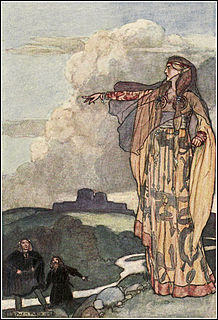
Macha was a sovereignty goddess of ancient Ireland associated with the province of Ulster, particularly the sites of Navan Fort and Armagh, which are named after her. Several figures called Macha appear in Irish mythology and folklore, all believed to derive from the same goddess. She is said to be one of three sisters known as 'the three Morrígna'. Like other sovereignty goddesses, Macha is associated with the land, fertility, kingship, war and horses.

Nemed or Nimeth is a character in medieval Irish legend. According to the Lebor Gabála Érenn, he was the leader of the third group of people to settle in Ireland: the Muintir Nemid, Clann Nemid or "Nemedians". They arrived thirty years after the Muintir Partholóin, their predecessors, had died out. Nemed eventually dies of plague and his people are oppressed by the Fomorians. They rise up against the Fomorians, attacking their tower out at sea, but most are killed and the survivors leave Ireland. Their descendants become the Fir Bolg and the Tuatha Dé Danann.
Conchobarmac Nessa is the king of Ulster in the Ulster Cycle of Irish mythology. He rules from Emain Macha. He is usually said to be the son of the High King Fachtna Fáthach, although in some stories his father is the druid Cathbad, and he is usually known by his matronymic, mac Nessa: his mother is Ness, daughter of Eochaid Sálbuide, King of Ulster.
There have been four Provinces of Ireland: Connacht, Leinster, Munster, and Ulster. The Irish word for this territorial division, cúige, meaning "fifth part", suggests that there were once five, and at times Meath has been considered to be the fifth province; in the medieval period, however, there were often more than five. The number of provinces and their delimitation fluctuated until 1610, when they were permanently set by the English administration of James I. The provinces of Ireland no longer serve administrative or political purposes but function as historical and cultural entities.

Rathcroghan is a complex of archaeological sites near Tulsk in County Roscommon, Ireland. It is identified as the site of Cruachan, the traditional capital of the Connachta, the prehistoric and early historic rulers of the western territory. The Rathcroghan Complex is a unique archaeological landscape with many references found in early Irish medieval manuscripts.

Lebor Gabála Érenn, known in English as The Book of Invasions, is a collection of poems and prose narratives in the Irish language intended to be a history of Ireland and the Irish from the creation of the world to the Middle Ages. There are a number of versions, the earliest of which was compiled by an anonymous writer in the 11th century. It synthesised narratives that had been developing over the foregoing centuries. The Lebor Gabála tells of Ireland being settled six times by six groups of people: the people of Cessair, the people of Partholón, the people of Nemed, the Fir Bolg, the Tuatha Dé Danann, and the Milesians. The first four groups are wiped out or forced to abandon the island; the fifth group represent Ireland's pagan gods, while the final group represent the Irish people.
The Ulster Cycle, formerly known as the Red Branch Cycle, is a body of medieval Irish heroic legends and sagas of the Ulaid. It is set far in the past, in what is now eastern Ulster and northern Leinster, particularly counties Armagh, Down and Louth. It focuses on the mythical Ulster king Conchobar mac Nessa and his court at Emain Macha, the hero Cú Chulainn, and their conflict with the Connachta and queen Medb. The longest and most important tale is the epic Táin Bó Cúailnge. The Ulster Cycle is one of the four 'cycles' of Irish mythology and legend, along with the Mythological Cycle, the Fianna Cycle and the Kings' Cycle.
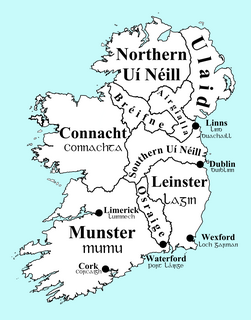
Ulaid or Ulaidh was a Gaelic over-kingdom in north-eastern Ireland during the Middle Ages made up of a confederation of dynastic groups. Alternative names include Ulidia, which is the Latin form of Ulaid, and in Cóiced, Irish for "the Fifth". The king of Ulaid was called the rí Ulad or rí in Chóicid.
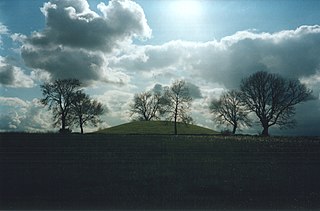
Navan Fort is an ancient ceremonial monument near Armagh, Northern Ireland. According to tradition it was one of the great royal sites of pre-Christian Gaelic Ireland and the capital of the Ulaidh. It is a large circular hilltop enclosure—marked by a bank and ditch—inside which is a circular mound and the remains of a ring barrow. Archeological investigations show that there were once buildings on the site, including a huge roundhouse-like structure that has been likened to a temple. In a ritual act, this timber structure was filled with stones, deliberately burnt down and then covered with earth to create the mound which stands today. It is believed that Navan was a pagan ceremonial site and was regarded as a sacred space. It features prominently in Irish mythology, especially in the tales of the Ulster Cycle. According to the Oxford Dictionary of Celtic Mythology, "the [Eamhain Mhacha] of myth and legend is a far grander and mysterious place than archeological excavation supports".
Áed Rúad, son of Badarn, Díthorba, son of Deman, and Cimbáeth, son of Fintan, three grandsons of Airgetmar, were, according to medieval Irish legend and historical tradition, High Kings of Ireland who ruled in rotation, seven years at a time. They each ruled for three seven-year stints. Áed died at the end of his third stint, by drowning in a waterfall which was named Eas Ruaid, "the red's waterfall", after him; previously the waterfall had been called Ess Duinn, the "Rapid of Donn", and his death is described as a miracle of sea and mighty wind. Díthorba and Cimbáeth then took their turn, after which Áed's daughter, Macha Mong Ruad, demanded to rule in her father's place. Díthorba and Cimbáeth refused, and battle ensued. Díthorba was killed. Macha forced Díthorba's sons to build her a palace at Emain Macha. She married Cimbáeth and the pair ruled for a further seven years, at the end of which Cimbáeth died of plague, and Macha became the only queen in the List of High Kings of Ireland.
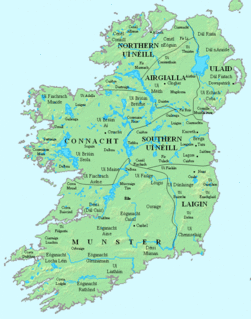
The Connachta are a group of medieval Irish dynasties who claimed descent from the legendary High King Conn Cétchathach. The modern western province of Connacht takes its name from them, although the territories of the Connachta also included at various times parts of southern and western Ulster and northern Leinster. Their traditional capital was Cruachan.
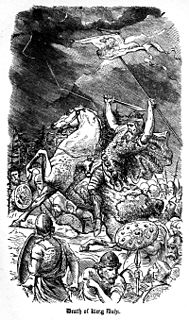
Nath Í, also known as Dathí, son of Fiachrae, son of Eochaid Mugmedon, was a semi-historical Irish king of the 5th century, the father of the likely-historical king Ailill Molt and the ancestor of the Uí Fiachrach dynasties of early medieval Connacht. His mother was Béḃinn. According to legend, he was a High King of Ireland, and died after being struck by lightning while on an expedition to the Alps.

Dál Fiatach was a Gaelic dynastic-grouping and the name of their territory in the north-east of Ireland during the Middle Ages. It was part of the over-kingdom of Ulaid, and they were its main ruling dynasty for most of Ulaid's history. Their territory lay in eastern County Down. Their capital was Dún Lethglaise (Downpatrick) and from the 9th century their main religious site was Bangor Abbey.
The Three Collas were, according to medieval Irish legend and historical tradition, the fourth-century sons of Eochaid Doimlén, son of Cairbre Lifechair. Their names were: Cairell Colla Uais; Muiredach Colla Fo Chrí ; and Áed Colla Menn. Colla Uais ruled as High King of Ireland for four years. Recent DNA analysis confirms the history of the Three Collas in fourth-century Ireland, but questions their descent from Eochaid Doimlén and Cairbre Lifechair.
Cairell mac Muiredaig Muinderg also Cairell Coscrach ("victorious") was a king of Ulaid from the Dal Fiatach. He was the son of Muiredach Muinderg mac Forggo and brother of Eochaid mac Muiredaig Muinderg, previous kings.
Eachaid mac Muiredaig Muinderg was a king of Ulaid from the Dál Fiatach. He was the son of Muiredach Muinderg mac Forggo. His death date is given in the Annals of Tigernach in 509. This annal gives him a reign of 489–509.
Muiredach Muinderg mac Forggo was a king of Ulaid from the Dál Fiatach. He was the son of Forgg mac Dalláin. His sobriquet means red-necked.
The Clanna Rudraige, Anglicised as Clanna Rory, is according to Irish mythology an ancient tribe that ruled the ancient province of Ulaid in Ireland. The people that lived in this province, also called the Ulaid, are claimed as being descended from the Clanna Rudraige and in medieval texts are often referred to by that name.
Eochu Buadach, son of Dui Ladrach, was, according to some redactions or versions of Lebor Gabála Érenn, a High King of Ireland. However, he is not included as a High King in other versions of the story. He was the father of two High Kings of Ireland, Ugaine Mor, and Bodbchad.
The Corca Oíche, meaning "the race of Oíche" was an ancient tribe, possibly of Pictish origin, existing since pre-Christian times in Ireland. It is possible that they descend from the Cruthin, a people whose territory existed near Lough Neagh in north-east Ireland. As such, some sources claim that they descended from the semi-legendary hero Dubthach Dóeltenga, or more commonly that they are descended from Oíche or Óchae, the daughter of Cronn Badhraoi of the Dál nAraidi, and her son Fergus Foga last king of the Ulaid to rule at Emain Macha.